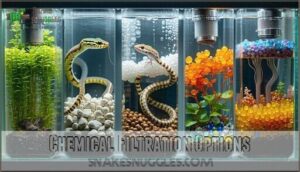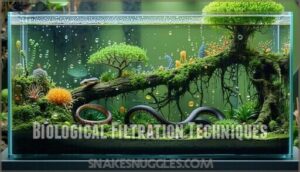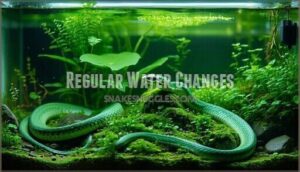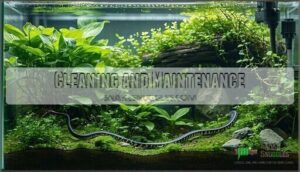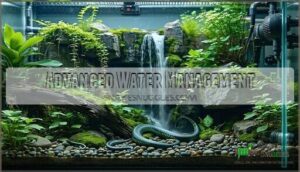This site is supported by our readers. We may earn a commission, at no cost to you, if you purchase through links.
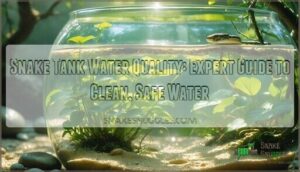
You’ll need to monitor pH levels between 6.5-7.5, maintain proper filtration, and perform regular water changes.
Dechlorinated water works best—avoid tap water with chlorine or chloramines that can irritate sensitive snake skin.
Temperature matters too; water should match your snake’s thermal gradient for ideal soaking behavior.
Testing kits help track ammonia, nitrites, and nitrates, which can spike from waste buildup.
Even the cleanest-looking water can harbor invisible threats that stress your serpent’s immune system, leading to shed problems and respiratory issues.
Table Of Contents
- Key Takeaways
- Snake Tank Water Basics
- Filtration Systems
- Maintaining Water Quality
- Advanced Water Management
- Frequently Asked Questions (FAQs)
- Is tap water ok for snakes?
- Is distilled water ok for ball pythons?
- How often should you change the water in a snake tank?
- Do snakes need dechlorinated water?
- How often should snake tank water be changed?
- What water temperature is best for snakes?
- Do different snake species need different water?
- How deep should water bowls be for snakes?
- Conclusion
Key Takeaways
- You’ll need to dechlorinate tap water since chlorine and chloramines can irritate your snake’s sensitive skin and harm their health through drinking and soaking.
- Monitor pH levels between 6.5-7.5 and test for ammonia, nitrites, and nitrates weekly to prevent invisible toxin buildup that causes stress and respiratory issues.
- Change water every 2-3 days to prevent bacterial growth, with daily changes being ideal for maintaining freshness and preventing contamination.
- Use proper filtration, combining mechanical, chemical, and biological methods to maintain water clarity and convert harmful waste into safer compounds through beneficial bacteria.
Snake Tank Water Basics
Creating the right water environment for your snake tank starts with understanding which water sources work best and what your specific species needs.
While snakes aren’t as water-sensitive as amphibians, proper water quality still affects their health, shedding cycles, and overall well-being through drinking water and humidity levels.
Quality water creates the foundation for your snake’s health, shedding success, and long-term vitality.
Water Source Selection
Choosing the right water source forms the foundation of your snake’s health, as different options carry distinct benefits and risks.
Tap water requires treatment, while spring water offers convenience with natural minerals. However, this is a key consideration: distilled water lacks minerals and should be avoided for drinking purposes.
- Tap water – Most accessible option, but needs dechlorinating treatment to remove chlorine and chloramines that harm snakes
- Bottled spring water – Premium choice with essential minerals intact, no treatment required, consistent quality guaranteed
- Well water – Cost-effective if tested regularly for contaminants, bacteria, and heavy metals to make certain safety
Water Quality Parameters
You’ll need to monitor five critical water quality parameters to keep your snake healthy.
pH levels should stay between 6.5-7.0, while ammonia and nitrite levels must remain near zero.
Nitrate levels should stay below 40ppm for safety.
Aquatic reptiles are particularly sensitive to heavy metals, chlorine, and chloramines.
| Parameter | Safe Range |
|---|---|
| pH levels | 6.5-7.0 |
| Ammonia levels | 0 ppm |
| Nitrite levels | 0 ppm |
Water hardness between 3-10dGH works for most species.
pH Adjustment becomes necessary when levels drift, while Hardness Control and Toxin Removal through proper filtration prevent health issues.
Monitor Solute Concentration carefully—when water evaporates, harmful compounds become concentrated.
RO Reconstitution with trace elements is essential if using pure water.
Filtration Types
Three primary water filtration systems work together to maintain pristine snake tank conditions.
Mechanical filtration captures debris using filter media like sponges, while chemical filtration removes dissolved toxins through activated carbon. Biological filtration converts harmful ammonia via beneficial bacteria colonies.
A quality system can be found at a snake tank filter.
- Mechanical filtration – Traps particulate waste using dense filter media requiring frequent cleaning
- Chemical filtration – Absorbs dissolved impurities through replaceable carbon or specialized resins
- Biological filtration – Establishes bacterial colonies that process toxic ammonia into safer compounds
- Aquatic filtration systems – Combine all three methods for maximum biofiltration efficiency and filter maintenance ease
PH Levels and Adjustment
pH levels between 6.0-7.8 work for most aquatic snakes, though species like tentacled snakes prefer more acidic water around 5.0-6.6.
Test your water pH regularly using reliable kits before making any adjustments.
When pH drifts outside the ideal range, use gradual methods like peat moss or crushed coral rather than rapid chemical changes that stress snakes, and always prefer reliable kits for testing.
Hardness and Mineral Content
Water hardness measures dissolved calcium and magnesium levels in your snake tank water, typically ranging from 4-8 dGH for ideal health.
Spring water provides beneficial minerals naturally, while RO water lacks them entirely, requiring mineral supplementation.
Softened water removes calcium and magnesium but adds sodium, making it unsuitable for drinking, and hard water can cause calcium buildup on tank surfaces.
However, hard water supports better pH stability and mineral content for your snake’s biological functions.
Chlorine and Chloramine Removal
Municipal tap water contains chlorine and chloramine disinfectants that pose serious threats to snake health through skin absorption and drinking.
Tap water’s hidden chemicals can harm your snake through both skin contact and drinking—always treat before use.
Reptile sensitivity to these chemicals requires immediate water dechlorination using commercial conditioner effectiveness or alternative methods like carbon filtration.
Testing methods help verify safe levels below 0.01 ppm. Chlorine removal happens instantly with conditioners, while chloramine removal takes longer, making proper treatment essential for snake welfare.
Filtration Systems
Your snake’s water quality depends on three essential filtration methods working together to create a healthy aquatic environment.
Mechanical filters trap debris and waste particles, chemical filters remove toxins and odors, while biological filters convert harmful ammonia into safer compounds through beneficial bacteria colonies, utilizing mechanical filters as part of the process.
Mechanical Filtration Methods
Your filtration system’s first line of defense catches visible debris before it wreaks havoc on water clarity.
Mechanical filtration traps particulate removal through physical barriers, preventing organic waste from decomposing and fouling your snake’s environment.
- Filter floss captures fine particles and requires weekly replacement to maintain peak flow
- Sponge cleaning involves gentle rinsing in tank water to preserve beneficial bacteria colonies
- Clogging prevention means regular filter maintenance schedules to guarantee consistent aquarium filtration performance
High-quality options for aquarium filter floss are readily available.
Chemical Filtration Options
Beyond physical filtration, chemical filtration tackles dissolved contaminants that mechanical methods can’t capture.
Activated carbon removes chlorine, heavy metals, and toxins through adsorption, requiring monthly replacement when saturated.
Zeolite filters bind ammonia via ion exchange, removing up to 97% efficiently.
Various resin types target specific contaminants like nitrates and phosphates.
Water conditioners neutralize chloramines instantly, while specialized media extends chemical lifespan through strategic placement in high-flow areas.
Biological Filtration Techniques
Biological filtration harnesses nitrifying bacteria to convert toxic ammonia into less harmful compounds through the nitrogen cycle.
You’ll establish beneficial bacteria colonies on biofilter media like bio-beads or sponges, where these microorganisms form protective biofilm growth.
Proper climbing structures also help boas thrive.
Maintaining proper oxygen levels guarantees efficient ammonia conversion, as these bacteria require well-oxygenated environments to thrive and process your snake’s waste effectively, which is crucial for a healthy environment and supports the overall biological filtration process.
Maintaining Water Quality
Establishing consistent water quality maintenance routines guarantees your aquatic snake remains healthy and stress-free throughout its life.
You’ll need to balance three critical components: regular water changes, systematic parameter monitoring, and thorough cleaning protocols that prevent harmful bacterial buildup without disrupting beneficial biological processes.
Regular Water Changes
Establishing consistent water changes prevents toxic buildup that threatens your snake’s health, with frequency benefits extending far beyond simple cleanliness.
Partial changes of 25-30% weekly remove accumulated waste while preserving beneficial bacteria, whereas full changes disrupt established biological processes.
This routine waste removal controls ammonia levels and nitrite concentrations before they reach dangerous thresholds.
Regular water changes also provide effective algae control, maintaining crystal-clear conditions that showcase your snake while supporting ideal water quality testing results, ensuring overall water quality.
Monitoring Water Parameters
You’ll need master test kits to measure ammonia levels, nitrite, and nitrate weekly—acceptable ammonia stays at 0ppm while nitrate should remain below 40ppm.
Digital pH meters provide accurate readings between 6.8-7.6 for ideal reptile health.
Smart monitoring systems offer real-time alerts and data logging, helping you spot dangerous parameter shifts before they compromise water quality and threaten your snake’s wellbeing.
Regular testing requires a good ammonia testing kit to ensure water quality.
Cleaning and Maintenance
Consistent cleaning and maintenance form the backbone of healthy snake tank water quality. Remove uneaten food within 24 hours to prevent bacterial blooms, while substrate cleaning should occur monthly for aquatic setups.
Equipment upkeep includes rinsing filter media weekly and replacing carbon monthly. Algae control requires balancing light exposure and nutrients through regular water changes and proper filtration.
To maintain hygiene, scrub bowls thoroughly to remove any stubborn residue. These preventative measures guarantee your aquarium maintenance routine supports prime conditions.
Advanced Water Management
Once you’ve mastered basic water maintenance, you’ll encounter more complex challenges that require advanced techniques and equipment.
These sophisticated methods help create ideal aquatic environments for water-dependent snake species while preventing common issues that can compromise your animal’s health, which is crucial for creating an ideal aquatic environment.
Cycling a New Tank
When you’re setting up a new aquatic snake habitat, you’ll need to establish beneficial bacteria before introducing your snake.
This process, known as Fishless Cycling, prevents dangerous ammonia spikes by using fish food or pure ammonia to feed developing bacteria colonies.
The process typically takes 4-6 weeks as bacteria convert ammonia to nitrite, then nitrate, and you’ll likely see a bacteria bloom making water cloudy initially—that’s completely normal.
Understanding the importance of substrate choices is also key for a healthy environment, and it’s crucial to monitor ammonia and nitrite levels weekly until both drop to zero, confirming your nitrogen cycle is complete.
Managing Nitrogen Cycle
Your biofilter’s bacterial colonies work around the clock, converting toxic ammonia into less harmful nitrate through a two-step process.
First, Nitrosomonas bacteria transform ammonia into nitrite, while Nitrobacter bacteria handle the final conversion to nitrate.
Monitor these levels weekly, as ammonia spikes can crash your entire system.
Maintain stable temperatures and avoid over-cleaning filter media to preserve this delicate bacteria balance and guarantee long-term cycle stability.
Using UV Sterilizers and Ozone Generators
UV sterilizers and ozone generators offer advanced pathogen control for snake tanks requiring pristine water conditions.
These devices complement traditional filtration by targeting microscopic threats that standard filters miss, particularly beneficial for aquatic species like tentacled snakes.
- UV Effectiveness: Eliminates 95% of algae within 72 hours while inactivating bacteria, viruses, and fungi through intense ultraviolet light exposure
- Sterilizer Lifespan: Replace UV bulbs every 6-12 months and clean quartz sleeves regularly to maintain maximum light transmission and pathogen control
- Ozone Safety: Monitor concentrations carefully as excess ozone can damage tissue; use carbon filtration and proper ventilation for safe operation
- Water Clarity: Both systems dramatically improve water clarity by removing suspended particles and organic compounds without altering water chemistry
Frequently Asked Questions (FAQs)
Is tap water ok for snakes?
Like knights of old seeking pure chalice water, you’ll find tap water works fine for most snakes. It’s generally safe, though chlorine and mineral buildup can occur over time.
Is distilled water ok for ball pythons?
Yes, distilled water is safe for ball pythons.
It’s 9% pure, won’t cause mineral buildup in equipment, and poses no health risks.
However, it lacks beneficial minerals, so make certain your python gets proper nutrition through their diet instead, which is a key factor for their overall health and proper nutrition.
How often should you change the water in a snake tank?
Picture droplets of condensation on a pristine water bowl – that’s your goal for maintaining ideal snake hydration.
You’ll need to change your snake’s water every 2-3 days, though daily changes are ideal for preventing bacterial growth and ensuring freshness.
Do snakes need dechlorinated water?
Reptiles generally don’t require dechlorinated water like amphibians do, since they’re less sensitive to chlorine and chloramines.
However, you’ll want to dechlorinate if your snake soaks frequently or drinks heavily from their bowl.
How often should snake tank water be changed?
Most reptiles’ water bowls accumulate bacteria within 48-72 hours of stagnation. You’ll need to change your snake’s water every 2-3 days, or daily for ideal health and hydration maintenance.
What water temperature is best for snakes?
You’ll want water temperatures between 75-85°F for most snake species, matching their thermal gradient needs.
Tropical species prefer the warmer end, while temperate snakes do well around 75-80°F for ideal hydration and health.
Do different snake species need different water?
While 90% of snakes can use standard dechlorinated tap water, species-specific needs vary substantially.
You’ll want softer water for sensitive species like green tree pythons, while hardier snakes tolerate harder water just fine.
How deep should water bowls be for snakes?
Water bowls should be deep enough for your snake to submerge its entire body if desired, but shallow enough to prevent drowning risk.
Most species thrive with bowls one-half to two-thirds their body diameter in depth, which can be considered a complete guideline for their water bowls.
Conclusion
Mastering snake tank water quality transforms your pet’s environment from merely survivable to absolutely thriving.
Your snake’s vibrant health depends entirely on maintaining pristine snake tank water quality through these proven techniques.
Remember, consistent monitoring prevents problems before they start, while proper water changes and filtration keep harmful compounds at bay.
You’ve learned the critical parameters, filtration systems, and maintenance schedules that separate successful snake keepers from those dealing with constant health issues, which is crucial for maintaining vibrant health.
- https://www.reddit.com/r/ballpython/comments/10s3flc/do_i_need_to_condition_my_snakes_water_if_so_any/
- https://community.morphmarket.com/t/ro-water-question/19568
- https://showmereptileshow.com/resources/the-importance-of-treating-your-reptiles-water-for-chlorine
- https://reptilesmagazine.com/herp-water-quality/
- https://www.merckvetmanual.com/exotic-and-laboratory-animals/aquatic-systems/environmental-diseases-of-aquatic-animals-in-aquatic-systems


